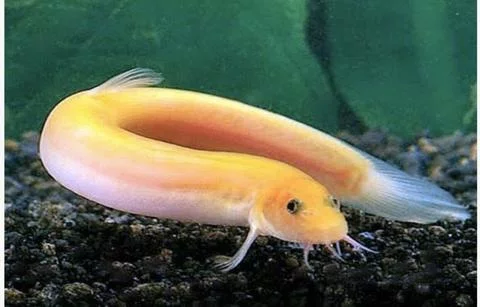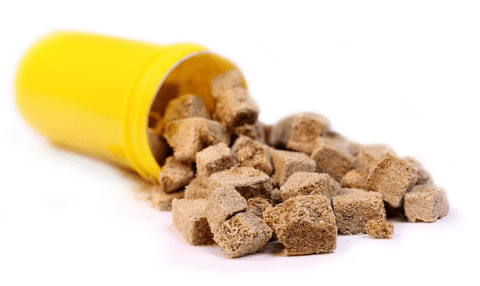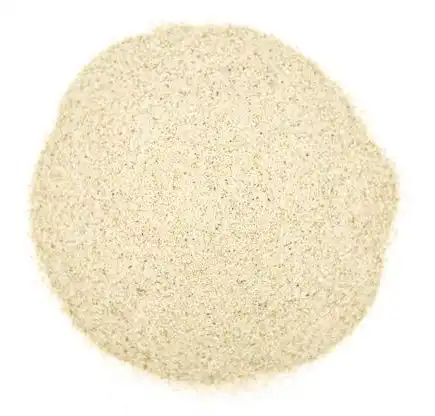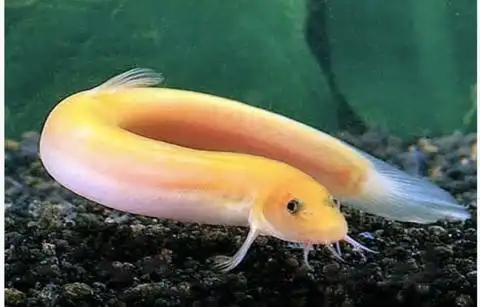Thank you for visiting! By the way… any links on this page that lead to products on Amazon and other stores/partners are affiliate links Aquarium Store Depot earns a commission if you make a purchase.
The Dojo Loach (Misgurnus anguillicaudatus), is an awesome freshwater fish that makes a really great addition to freshwater aquariums. These eel-shaped fish have loads of personality and can be very entertaining to watch as they explore the bottom of the fish tank.
In this article, I’ll cover everything you need to know about Dojo Loach care, so let’s get started!
Species Overview
| Scientific Name | Misgurnus anguillicaudatus |
| Common Names | Dojo Loach, Weather Loach, Japanese Weather Loach, Weatherfish, Pond Loach, Oriental Loach, Dojo Fish |
| Family | Cobitidae |
| Origin | Central & Eastern Asia from Siberia to Vietnam. Introduced widely |
| Diet | Carnivore |
| Care Level | Easy |
| Activity | Moderate |
| Lifespan | 7-10 years |
| Temperament | Peaceful |
| Tank Level | Bottom |
| Minimum Tank Size | 55 gallons |
| Temperature Range | 59° – 77°F |
| Water Hardness | 1 – 12 dKH |
| pH Range | 6 – 8 |
| Filtration/Water Flow | Low |
| Water Type | Freshwater |
| Breeding | Egg-layer |
| Difficulty to Breed | Difficult to breed |
| Compatibility | Species-only tank or community tank |
| OK, for Planted Tanks? | Yes, but known to uproot plants |
Origins and Habitat
The Dojo Loach is a fish species with a pretty wide distribution. They are native to the countries of:
- Russia
- China
- Japan
- Korea
- Vietnam
Today, the Dojo Loach has an even wider distribution because it has been introduced to many countries outside of its natural range. Sometimes these fish escape when kept in ponds, and sometimes people release them into local waterways.
As a result, you can find these fish swimming wild in parts of Europe, The USA, and Australia. Their natural habitat is ponds, swamps, and shallow streams with a soft, muddy substrate.
What Do They Look Like?

The Dojo Loach is a long, eel-like fish. They have a small, rounded tail and a similar-sized dorsal fin that is set quite far back.
Like other loaches, the Weatherfish has 1o little whiskers around its mouth. These structures are actually called barbels and they help the fish to find food.
Varieties
Their color varies a lot and they can be plain, striped, or marked in spots and blotches. In the aquarium hobby, interesting albino and golden color morphs are also available.
- Golden Dojo Loach
Gold Dojo Loaches are a really cool color morph that has a plain, golden yellow body color, usually with dark eyes.
- Albino Dojo Loach
Albino Dojo Loaches can be a little lighter in color than the gold dojos and have red eyes.
Size
Dojo Loaches are medium-sized fish that usually grow to about 6 inches long in the home aquarium. They can grow to double this size in the wild, however. If you can provide them with a nice big aquarium and great water quality, you might just be surprised at how big they grow!
How Long Do They Live?
The Dojo Loach is a pretty long-lived fish that will usually survive for 7-10 years in the aquarium. Of course, the better its living environment, the longer your pet is likely to live, so make sure you read the sections about the diet and tank set up for these awesome fish.
Dojo Loach Care Guide
One of the reasons that Dojo Loaches are so popular is that they are friendly fish with great personalities. In case you’ve been wondering about why the Dojo Loach is also known as a Weather loach, this next fact will amaze you.
These fascinating fish can predict changes in weather. They don’t use satellite imagery or any fancy technology for this, rather the barometric pressure changes that happen before a storm causes their activity levels to spike.
So if you see your Weatherfish spring into action and start getting restless, it might be time to shut the windows and get ready for some rain. Apart from this, Dojo Loaches can be pretty inactive fish.
They love hanging out at the bottom of the tank and hiding in caves or under rocks and driftwood. They also enjoy digging through the substrate and you’ll often find just their little faces sticking up out of the sand.
What Are Good Tank Mates?
The first tank mate to get for your Weather Loach is definitely a few more Weather Loaches! These fish are most comfortable in groups and will be more bold and active with a few friends around. That doesn’t mean you can’t keep them in a community tank other species as well though.
Before we get onto a few specific ideas, here are a few general pointers for choosing Dojo Loach tank mates:
- These fish require cooler water, so it’s important that you select tankmates that enjoy lower water temperatures
- Choose similar fish that are not known for aggression or fin nipping
- Avoid large predatory fish
- Try to choose some mid and topwater tank mates to avoid overcrowding the bottom of the tank
Best Tank Mates for Them
Now that you know what to look out for, here are a couple of great species that I would recommend:
- Leopard Danios
- Zebra Danios
- White Cloud Minnows
- Kuhli Loach
- Rosy Barb
Least Compatible Fish for Them
Unfortunately, warm-water tropical fish will not be good tankmates, unless they are comfortable in temperatures of below about 77°F. Here are a few examples of fish that are not recommended:
- Oscars and other large cichlids
- Larger catfish
- Warm water fish like Discus
Goldfish
There are too many reports of Dojo Loaches attacking Goldfish to ignore. While keeping them together with Common Goldfish is probably perfectly safe, less agile fancy Goldfish should probably be avoided.
Invertebrates
These bottom dwellers feed on invertebrates like snails, crustaceans, and insect larvae. This means that they are not good tank mates for shrimp and snails.
In fact, Weather Loaches can be very handy for controlling pest snail populations in freshwater aquariums. Although larger shrimps like Amanos will probably hold their own against Weather Loaches, I wouldn’t recommend taking the risk.
What Do They Eat?
In nature, Dojo Loaches are carnivores. They hunt the bottom of swamps and streams for small invertebrates like worms and insect larvae, snails, and small crustaceans. They would also certainly take fish larvae and eggs.
Let’s take a look at how to provide them with a healthy diet:
Prepared Foods

As far as processed foods are concerned, bottom feeder tablets or sinking pellets are the best options for these fish. They will eat flake food but they don’t usually feed from the water surface.
It’s really fun to watch these fish feed. Once the tablet has reached the bottom of the tank (or sometimes even before), they will smell the food and begin searching the bottom of the tank. Once found, the feeding frenzy begins as they playfully wrestle each other, taking turns feeding on the shrinking pellet.
Another reason that this fish species can be so fun to keep is that, with a little patience, they will happily eat right out of your hand if they like the food you are providing.
Live & Frozen Foods
Feeding frozen and live foods is a great way to provide your Dojo Loaches with a natural food source. If you have other schooling fish in the tank like minnows or danios, your loaches might not get much before it’s all eaten though.
One way to limit this competition is to feed enough for all of your fish to get a good helping. Alternatively, you can add your live/frozen foods just after your other fish have had their fill of the pellets or tropical flakes they usually feed on.
Some great live/frozen foods that you can feed your Dojo Loaches include:
- Blood Worms
- Brine Shrimp
- Tubifex Worms
How Much and How Often to Feed Them
If feeding sinking foods like bottom feeder tablets, you can feed these fish every day or every second day. It really depends on the amount of food you are providing, as well as the number and size of your fish.
In order to prevent overfeeding, make sure you aren’t feeding more than your fish can eat in one go. Uneaten food in the tank tends to cause nasty ammonia spikes and reduced water quality.
Tank Setup
If you want your Dojo Loach to live the longest, healthiest life possible, you’ll need to create an awesome tank where it can feel right at home. Here’s how:
Tank Size
When it comes to choosing the best tank size for aquarium fish, you must consider both the size of the fish and their habits. In the case of the adult Weather Loach, you’re going to need a tank of at least 55 gallons.
When you first get your dojos, they might be just a few inches long, but then they still have plenty of growing to do! A mature Dojo Loach can reach nearly a foot long.
These fish don’t spend a whole lot of time swimming in the open water, so a tank with a large footprint is ideal so give them plenty of room to explore the bottom.
Don’t Forget the Lid/Hood
You might not think it by looking at them, but loach species tend to be great jumpers. Sadly, these fish will jump out of aquariums without lids, and usually, this ends in tragedy. For this reason, dojos should only be housed in aquariums with tight-fitting lids. If you are considering a rimless aquarium, purchase a glass lid from the manufacturer or store you purchase from.
Plants
Growing live plants in your aquarium is pretty much always a great benefit for your fish. Sometimes, however, the fish aren’t so good for the plants, and this can be the case with the Dojo Loach.
These fish are natural-born diggers, and they just love to crawl through the roots of plants. Unfortunately, this often disturbs the plants and sometimes uproots them completely.
While dojo loaches aren’t a great choice for carefully designed aquascapes, you definitely can keep them in planted tanks. I would suggest growing epiphytes that grow attached to driftwood, floating plants, or leaving stem and rosette plants in their pots.
Some great plants to use are:
Plants to avoid
- Dwarf Hair grass
- Micranthemum ‘Monte Carlo’
- Baby Tears
Substrate
Pond Loaches are bottom dwellers that love to dig and explore the bottom of the tank. They have sensitive whiskers called barbels, and their bodies are not covered in protective scales. This means that they can easily hurt themselves in a sharp, coarse substrate.
In their natural habitat, these fish prefer mud and soft sand, but the best aquarium substrates for them is definitely fine sand or rounded gravel.
Natural sand is excellent for bottom feeder fish to forage around in.
Decor
Apart from burying themselves in the substrate, Weather Loaches also love to hang out in caves and other hiding places. You can make up your own hiding places by stacking rocks or driftwood carefully, just make sure you arrange your hardscape securely to prevent any accidents during tank maintenance.
If you prefer ready-made options, you can always pick up some aquarium ornaments like artificial caves, castles, or sunken ships.
Water Quality
When it comes to aquarium husbandry, maintaining great water quality is the most important factor for success. Let’s take a look at how to keep your aquarium clean and healthy:
Filtration
A good quality filter is essential for keeping your tank clean and safe for your pets. When it comes to Dojo loaches, any type of filter is fine, although these fish do not enjoy very strong water flow.
One important tip is to go ahead and cover up your filter intake to be on the safe side because loaches love to hide, and often find their way inside filters.
Water Parameters
One of the most important things to remember is that Dojo Loaches aren’t tropical fish, so you probably will not need to run a heater to keep your water temperature in the right range. Be aware that if you live in a tropical area, the water temperatures in your tank might rise to warmer than 77°F even without a heater.
Apart from their temperature needs, Weather Loaches are very hardy fish that will do well in most setups. They are happy in slightly acidic to slightly alkaline water, with a range of hardness values.
Aquarium Maintenance
You will need to perform regular partial water changes to keep your aquarium water safe and healthy for your pets. Although Dojo Loaches are not very sensitive to water conditions, they definitely deserve the best conditions that you can provide for them.
Water changes are a pretty easy and straightforward job that you can do every week or two. If you’re not sure about how to change the water in your tank, go ahead and check out this article for all you need to know!
Test Tank Conditions
Even with a great quality filter and regular maintenance, the only way to know how good your water parameters are is to test. Your local fish store can test your water for you, but I would definitely recommend picking up a test kit.
Testing your water is easy, and this way, you’ll be able to pick up any problems before they turn into a headache! The most important parameters to test for are:
- Ammonia
- Nitrite
- Nitrate
- pH
Breeding
Few aquarists have managed to breed this fish species in the home aquarium. That being said, it does happen and many fry have been successfully raised this way. the greatest challenge is that this often seems to happen out of the blue, so it is unknown exactly what triggers breeding and how to create these conditions in the tank. I supplied the video above from FishyBusiness. I’ll explain in text below.
Sexing
The most visible difference between male and female loaches is the size and shape of their pectoral fins. These fins are located just behind the fish’s gills.
In the male, they are larger and more triangular in shape when looked at from above. The female’s pectoral fins will be rounder in profile and a little smaller.
Getting Your Fish Ready to Breed
It is not known exactly what makes Dojo Loaches get into the mood to breed in the aquarium. Many fish are stimulated to breed by a change in barometric pressure, water temperature, and current that mimics a change in the seasons.
When it comes to Weather Loaches, there are no guarantees though, so your best chance is probably just to provide your fish with a great home with perfect parameters and a high-quality diet that includes live/frozen foods like Tubifex worms or black worms.
Health and Disease
Dojo Loaches are usually very hardy, low-maintenance fish for cool water aquariums. They do pick up issues from time to time though, so let’s take a look at how to identify and avoid health problems.
Evaluating Their Health
Whether you’re picking out a new pet at the fish store, or just keeping an eye on the health of the fish in your tank, there are some important things to look out for.
A healthy Dojo Loach will spend a lot of its time hiding out in the substrate or under the hardscape of your aquarium. This is normal behavior, so don’t worry if they seem a little inactive. Around feeding time they should get a lot more lively, however.
Signs of poor health to look out for are:
- Clamped fins that are held tight against the fishes sides
- Floating caused by swim bladder issues
- Worn barbels that could indicate infection or damage from a sharp substrate
- White spots or patches on the skin that caused by parasites and fungal infections
- Swollen external gills
Common Health Issues
Although Dojo Loaches are very hardy aquarium bottom feeders, these are the issues that they are most likely to have:
- Skin infections
- Ich
- Swim bladder disease
Weather Loaches don’t have any scales which means their skin is very sensitive to damage. These fish love to dig, so avoid keeping them in a tank with a sharp substrate that could injure their skin and barrels, leaving them vulnerable to infections.
The best way to avoid illness is to make sure you keep your water quality high by running good filtration and performing regular water changes. Keeping Weather Loaches in water that is too warm will also stress your fish, which can lead to infections and other health issues.
Where to Buy
Dojo Loaches are common fish in the aquarium trade, and you can usually find them at your local fish store or online. I recommend checking out Flipaquatics because they keep great quality stock and back it up with a 100% live arrival guarantee to take the stress out of online shopping. They also stock the amazing golden form when available and quarantine all their fish!
A bottom-dwelling fish that is very adaptable. Compatible in both tropical and coldwater environments
Frequently Asked Questions
What do they eat?
Dojo Loaches hunt for small invertebrates like worms and crustaceans. In the aquarium, they can be fed sinking pellets and tablets as well as frozen foods like bloodworms.
Are they Hardy?
Dojo Loaches are one of the hardiest aquarium fish out there, and many people even keep them outdoors in ponds. This isn’t recommended though because these fish have escaped ponds and gotten into local waterways where they are invasive.
What size tank do they need?
Dojo Loaches grow to over 10 inches in length. A minimum tank size of about 55 gallons is recommended for keeping adults.
What fish can go with them?
The best fish to keep with Dojo Loaches are other peaceful fish like Danios and White Cloud Minnows that also prefer a cooler water temperature.
Closing Thoughts
Dojo Loaches deserve a spot in just about any unheated freshwater aquarium. These funny freshwater fish are easy to care for and very entertaining to watch as they explore the lower levels of the tank. You can use the information in this guide to help you provide your Weather Loach with the best care.
- About the Author
- Latest Posts
I’m thrilled that you found Aquarium Store Depot! Here you’ll find information on fish, aquariums, and all things aquatics related. I’m a hobbyist (being doing this since I was 11) and here to help other hobbyists thrive with their aquariums! I adhere to a high quality Editorial Process and Review products with real life field usage and practical analysis.








Thank you for all this information. I came here looking for the best fake plants that wouldn’t hurt them since I can’t keep live ones down haha
But found so much more information that is so helpful to know.
Thank you this was very helpful
You are welcome 🙂